The ‘Group of Death’ title is traditionally given to the most brutal group in the tournament’s group stage, in which multiple top teams are battling out who will get into the next round.
In EURO 2024, group D was given that ambitious title.
With two of the tournament favourites in the Netherlands, the World Cup runner-up in 2022 France, and two decent teams in Poland and Austria, the group seemed to be the by far strongest in the competition.
Still, most people believed that the Netherlands and France were going to battle for the top two places.
But in actuality, Ralf Rangnick‘s team came up top of the group with six points, and their only loss came to France because of an own goal.
All while missing their superstar and captain, David Alaba.
In this tactical analysis, we will provide an analysis of how a small country like Austria managed such a miraculous feat.
Austria Euro 2024 Line Ups
During the three games in the group stage, Rangnick used a lot of player personnel.
He was one of the few coaches who actively used his squad depth and rotated quite a bit.
One thing stayed the same during all three games, though: Austria operated out of a 4-2-3-1 formation.
While goalkeeper Patrick Pentz played all three games, Rangnick used different players in almost every other position on the field.
He rotated his centre-backs and gave Maximilian Wöber, Gernot Trauner, Phillipp Lienhart and Kevin Danso all meaningful playing time.
Only Marcel Sabitzer was constantly playing in his offence.
Rangnick used Marko Arnautovic and Michael Gregoritsch up front, while he used Kondrad Laimer, Patrick Wimmer, Christoph Baumgartner, and Romano Schmid as compliments to Sabitzer.
These rotations made Austria pretty unpredictable for their opponents, helping them switch up their styles and adapt to their opponents.
The games against France and Poland were quite different from the game against the Netherlands, and Rangnick once again proved that he is a football mastermind with his line-ups.
Is Austria better Than Germany?
Red Bull Salzburg took over Austrian football in a hurry.
During these last years, they completely took the reins in terms of youth football in the country, and other teams like SK Sturm Graz or LASK have been heavily influenced by the Red Bull way of playing, which means a lot of the younger players in the Austria squad learned to play the game that way.
And guess who the coach Red Bull picked to develop their philosophy was: Ralf Rangnick.
It’s a match made in heaven.
But there is another country whose football scene was heavily influenced by Ralf Rangnick: Germany.
Funnily enough, both of those countries are now playing in a pretty similar fashion and having a lot of success during the Euros.
The most glaring similarity between the both teams is their offensive midfielders in their 4-2-3-1 formation.
Both teams are not using traditional wingers but rather are playing with three attacking midfielders as number 10s.
This means both teams have a narrow shape and ultimately dominate the half-spaces.
With control in these areas, it is tough to get a grasp on the attackers for the opposing defence, resulting in hard decisions to make for the backline.
In Austria’s case, their narrow shape gives them two huge advantages.
The first advantage is that they control the centre of the pitch, which opens up many opportunities for combinations.
The game against Poland differed significantly from the other two because Austria was favoured to win.
They knew they had to play well with the ball and showed way more ball security than counterpressing-focused teams usually do.
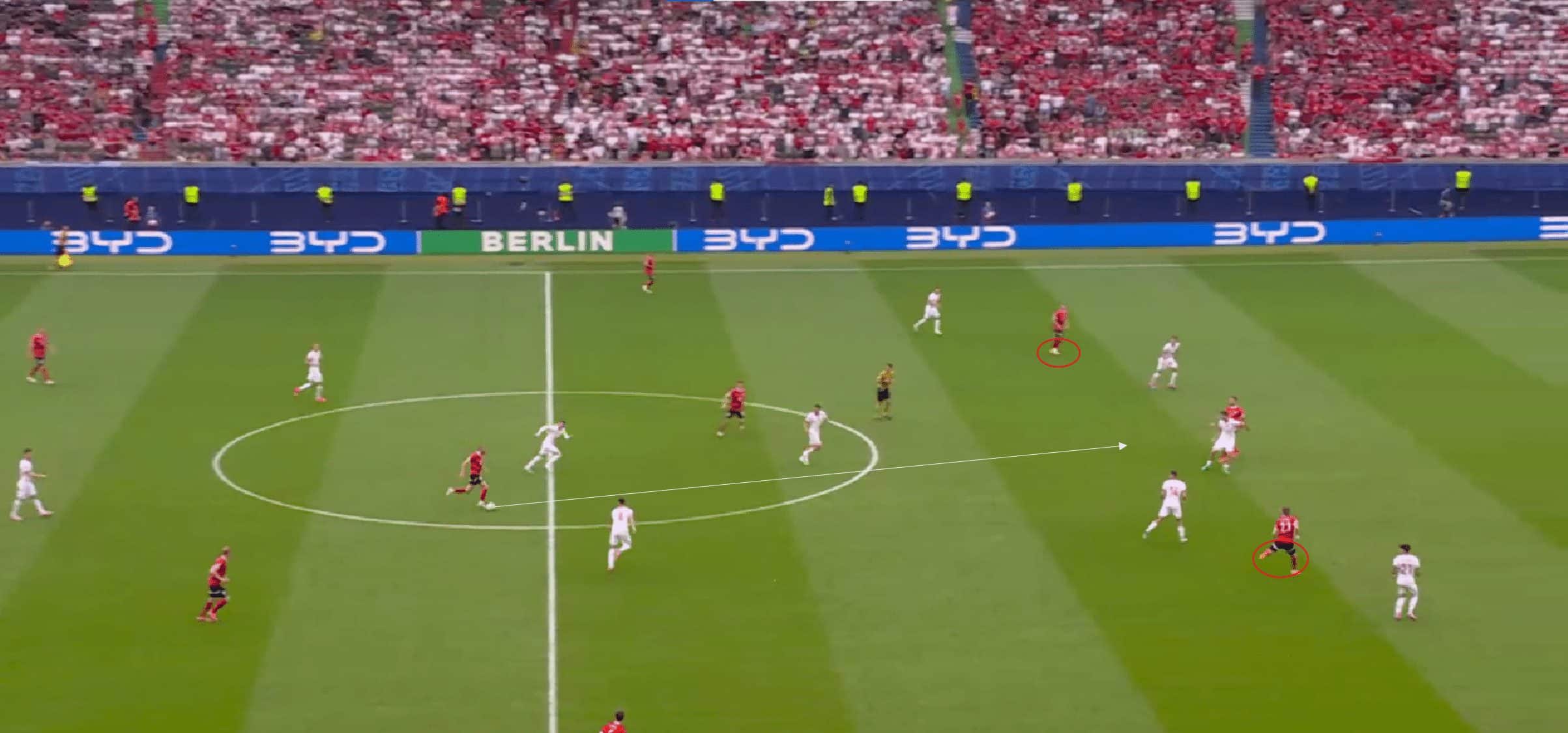
In this example, Austria control the centre of the pitch, creating open space for a pass straight to their striker Arnautović.
Now, he has multiple teammates around him to start a combination in the final third.
Also, both full-backs have acres of space in front of them to start a deep run.
This allows Austria to progress the ball relatively easily into the final third and has ball security and depth in its attacking game.
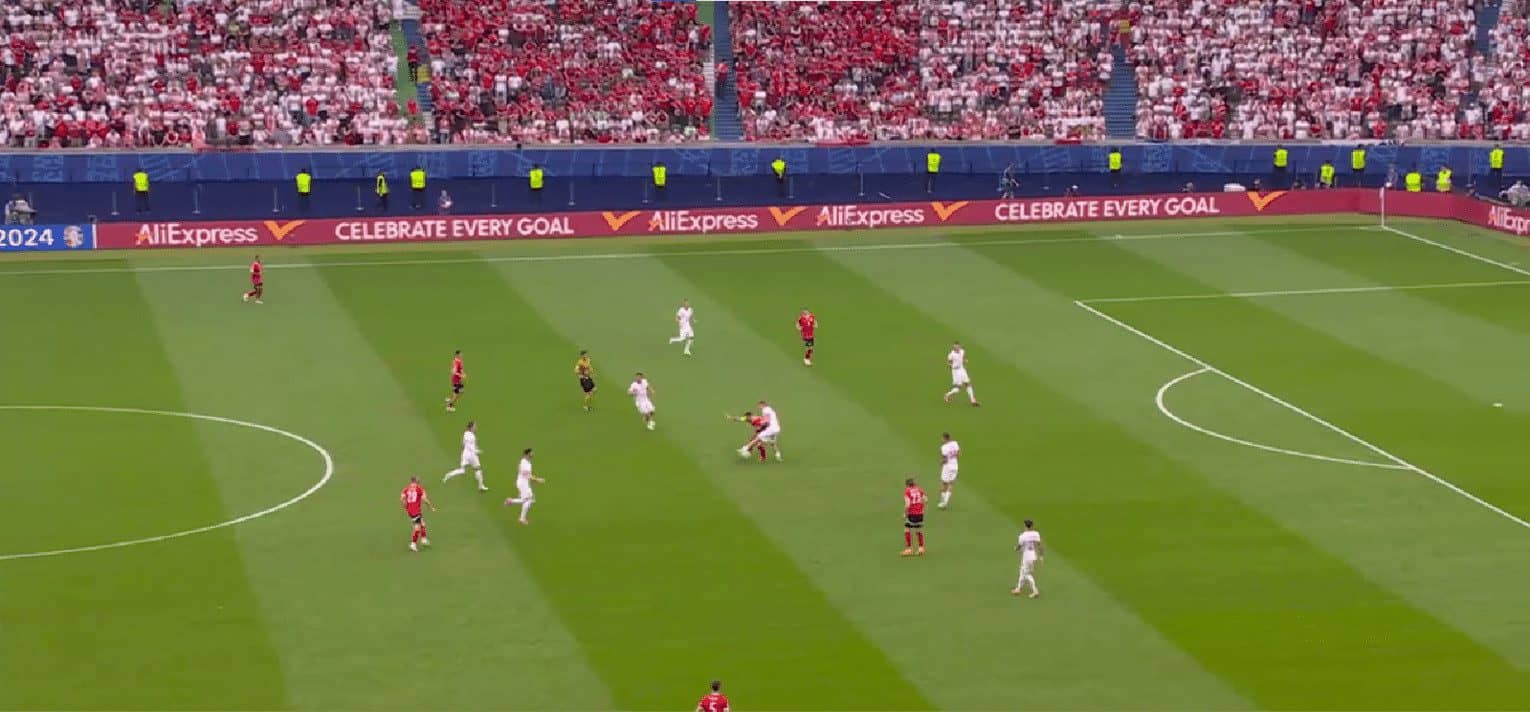
Another huge advantage the Austrians gained through their shape was the ability to instantly initiate their counterpress.
While limiting their adequate playing space, Rangnick makes sure that after a loss, Austria has a lot of men in the area to force high recoveries and prevent counterattacks.
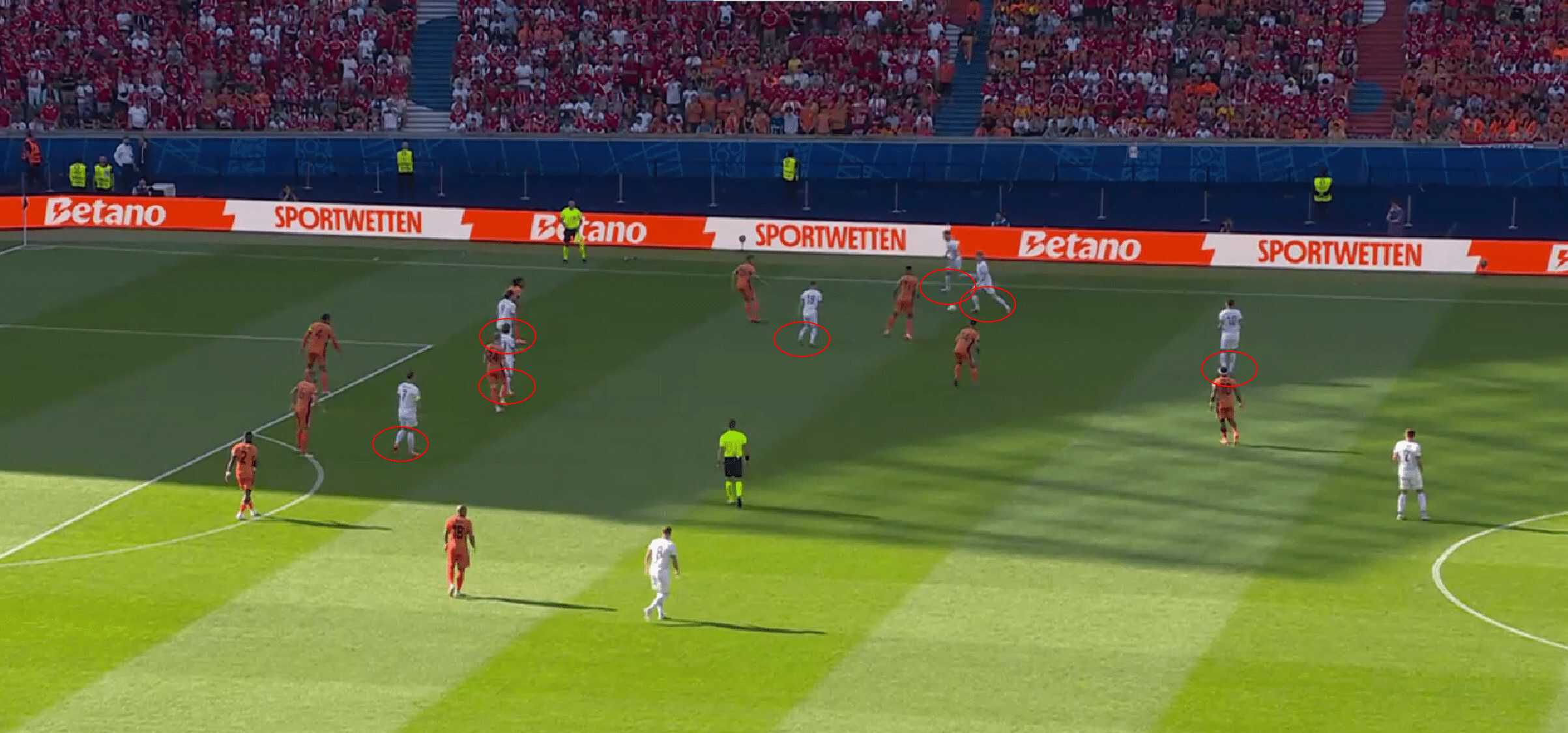
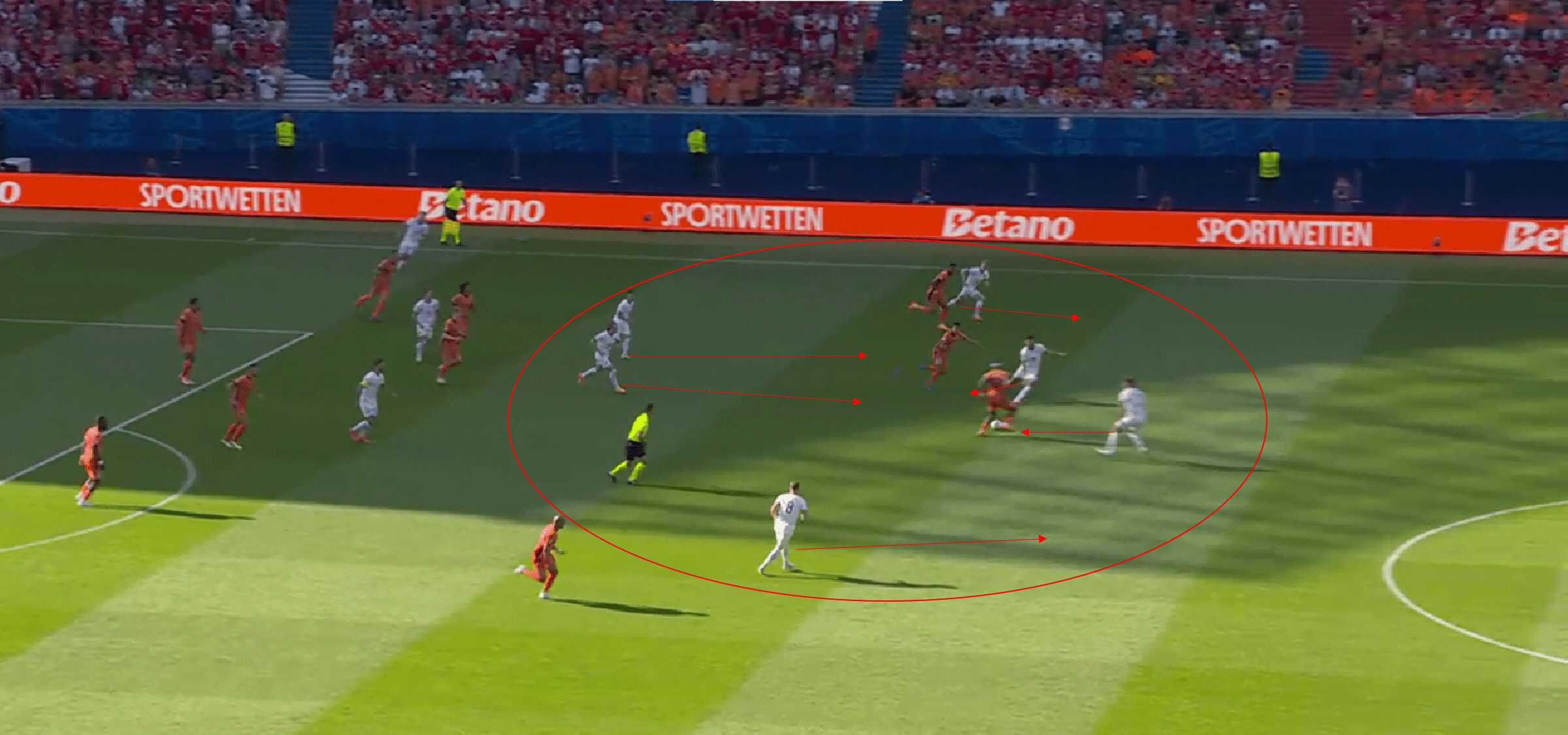
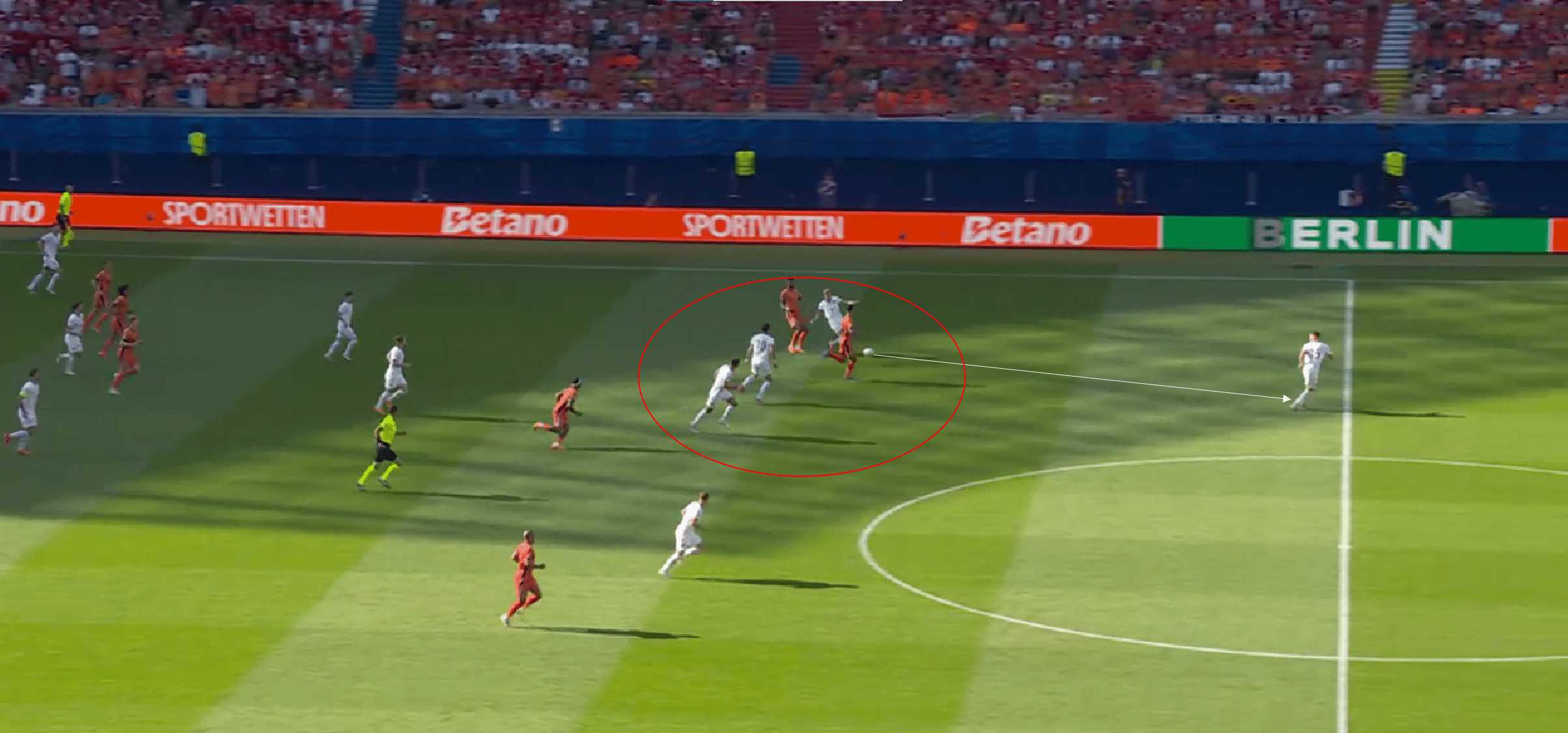
Regarding two key statistics, Austria ranks second in passes per defensive action and overall challenge intensity.
This shows that Rangnick’s style of play is implemented well.
Austria puts a lot of pressure on the ball after losing it and is highly intense in its play, permanently challenging its opponents in tough duels.
The only team that outranks Austria in those two categories is Germany.
Of course, Germany uses the advantages of the narrow shape as well as Austria does, something that Rangnick has taught German coaches since the 1990s.
While there are a lot of similarities, Austria lacks the creativity and take-on-ability that Florian Wirtz and Jamal Musiala provide for Germany.
This leads Austria to be more dependent on their counterpress than Germany is in creating scoring opportunities.
So, are Austria better than Germany? In some ways, yes, but overall, no.
The one thing Austria has proven, though, is that they can beat tough opponents, something Germany didn’t have to do in their group up until now.
Still, Austria is on a good trajectory to actually being as good as their big neighbour, and Rangnick’s influence on both teams is easily visible in every game.
Ralf Rangnick Tactics – Releasing full-back into open space
Playing in a very narrow formation has many downsides as well.
While being able to get into your counterpress is an important part of the modern game, Austria is compromising its own effective playing space by letting its wingers drive in all the time.
To still be able to play the ball in their possession, Rangnick men tend to cover the width of the field with their full-backs, especially their left backs, Alexander Prass and Phillipp Mwene.
While Mwene started in the first game against France and the Poland game, Prass took over the reins during the latter half of the group stage and has been a vital point of Austria’s attack ever since.
Donyell Malen’s own goal was a perfect example of why Prass is starting for the Austrians now.
His left winger, Patrick Wimmer, is pushing inwards, dragging a very man-oriented right back in Denzel Dumfries with him because he still needs to mark him.
Overall, Austria is overloading the centre of the pitch to create a numerical advantage.
This means that there is a lot of vacant space in front of Alexander Prass, where Dumfries just left.
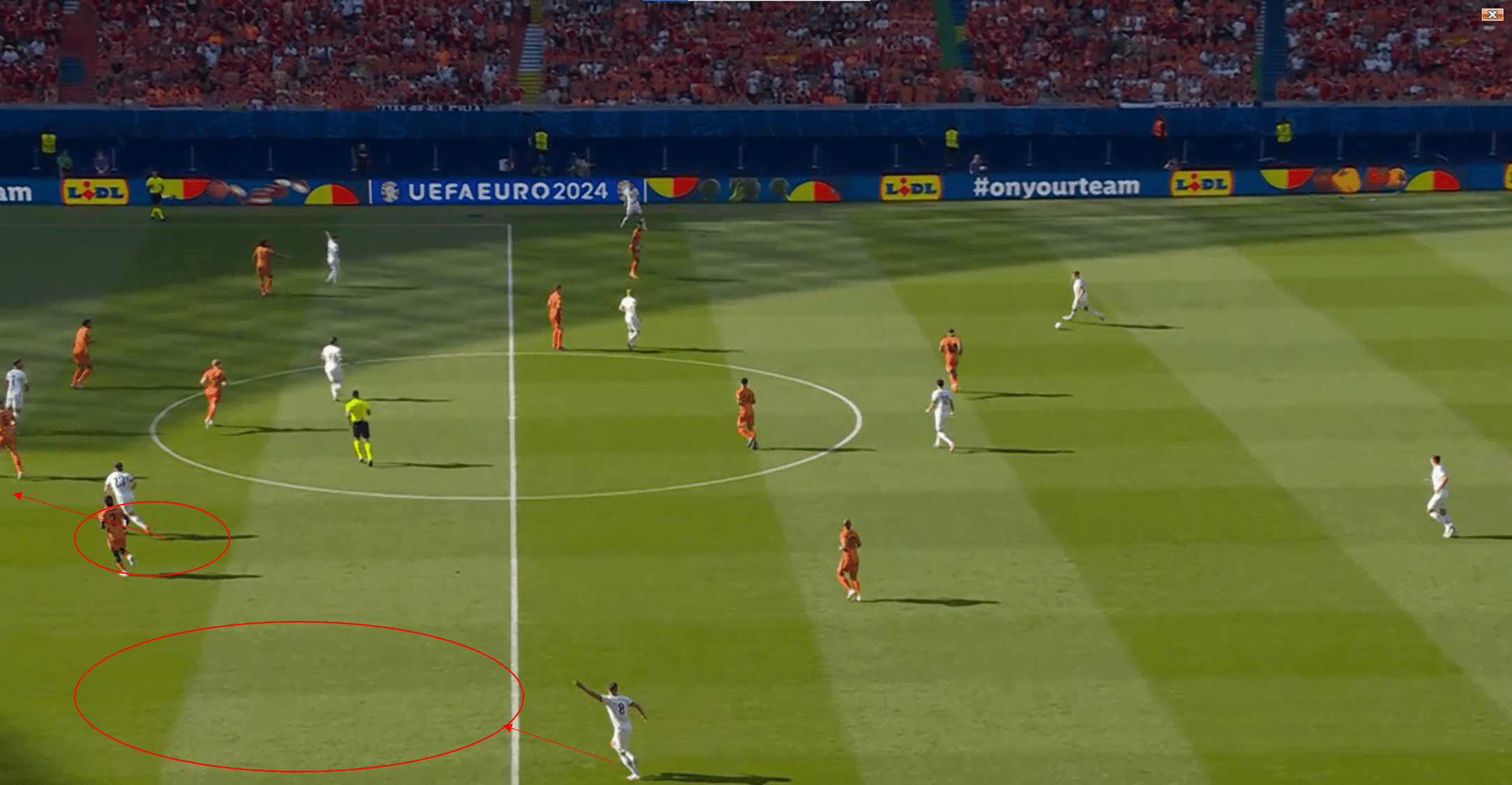
Prass realizes the situation immediately and moves forward into the space, asking to receive the ball.
Lienhart plays the ball to Arnautović in the centre of the pitch, using the advantage created there, who then releases Prass into the open space with an easy pass.
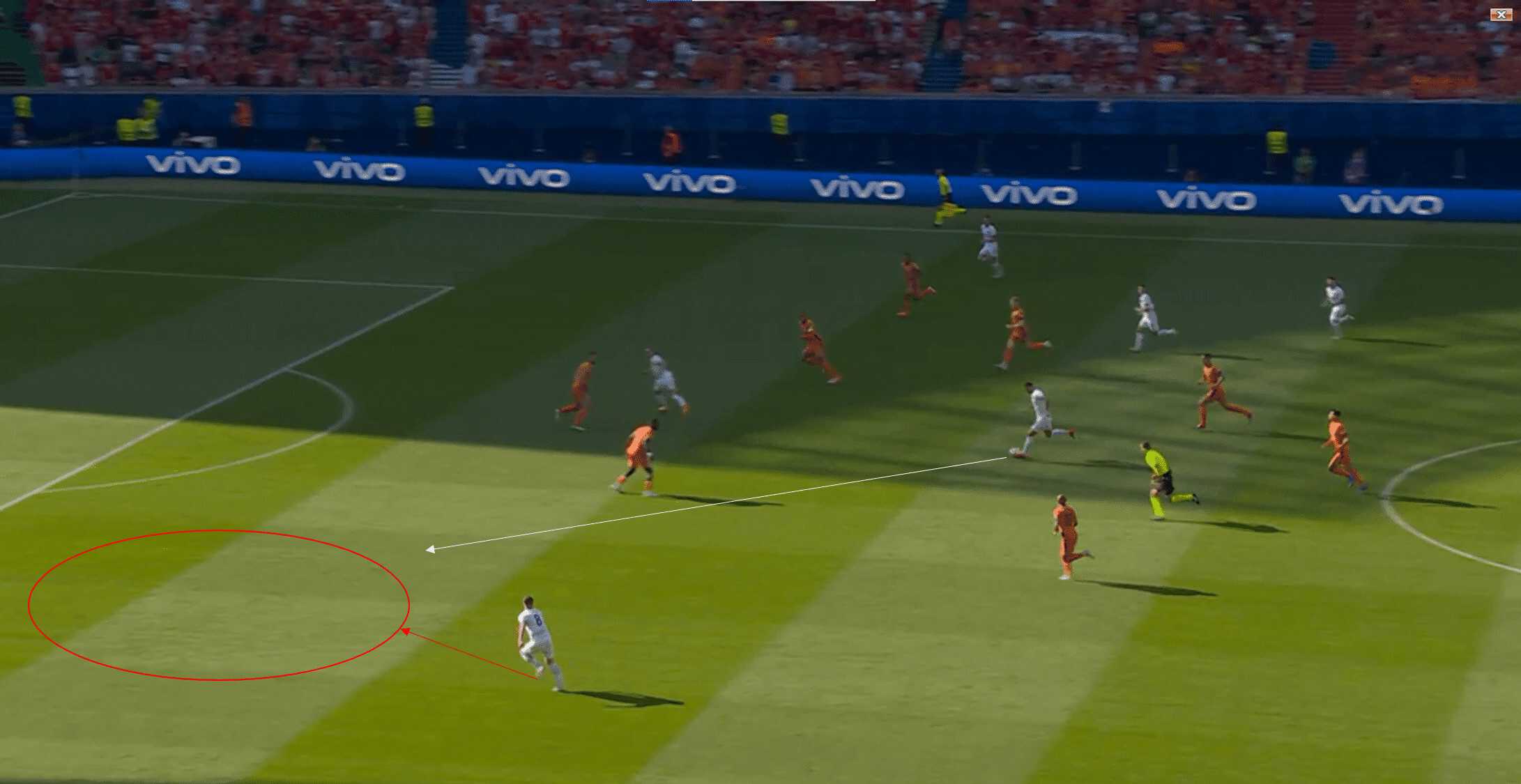
From then onwards, Prass only needs to receive the ball well and cross it square towards goal, where a husteling Donyell Malen was not able to collect his feet well and puts the ball into his own net.
These types of situations happen frequently with Austria, another glaring similarity to the German national team.
Wirtz and Musiala also push inwards, and Kimmich tries to receive the ball from Kroos in the vacant space.
While Rangnick’s team manages to create many chances this way, they are also taking a significant risk.
Their full-backs pushing forward this aggressively mean that there is a lot of space behind them, which the opposing team can exploit.
While their counterpress and intensity are great and prevent most teams from exploiting the Austrians’ positional play in transition, they still struggle after losing the ball.
Especially in the game against France, Mbappé and Griezmann constantly moved Stefan Posch and Phillipp Mwene out of position and then used Mbappé’s pace to get in behind Austria’s defensive line.
Looking at the bigger picture, the trade-off is still worth it for the Austrians.
Mwene and Prass have three combined assists in the last two games, which is excellent for full-backs.
Rangnick also creates an asymmetrical way of playing because his team is looking to release their left backs into space rather than doing it with Stefan Posch on the right.
Alexander Prass has been a really nice addition to the team these last two games, while Mwene still has been playing allright, Prass timing and movement in his deep movements are better than those of Mwene, which helped Austria to create opportunities to cross the ball towards goal.
Threat from crosses
Overall, Austria managed to score a decent six goals through their three matches, scoring three in each of their last two matches after going scoreless against France in their opener.
Four of those six goals came from crosses off the left attacking side of Rangnick’s team, a clear pattern.
We already talked about releasing their left-backs into space, and that’s obviously a massive part of why they score off of these crosses well, but it’s not the only reason.
Austria’s narrow shape also allows them to have a much better presence inside the box than other teams.
All four of their offensive players can usually make runs into the box and receive a cross.
Romano Schmid’s goal against the Netherlands is an excellent example of this.
While Austria are playing on their left side, they are releasing Florian Grillitsch in behind the defence this time because the Dutchmen tried too aggressively to cover Alexander Prass this time.
Romano Schmid is on the far side of the pitch, but because he pushed in already, he can easily make the run into the box, and after Sabitzer pulled the two centre backs into the six-yard box, Schmid was able to finish the cross with a header from not even ten yards out.
It is a straightforward way of creating goalscoring opportunities, but it works well.
Their great counterpress also complements it; even if the ball gets cleared or headed away, their shape allows the Austrians to easily press the second ball and force a deep recovery to catch the opposing team off guard once again.
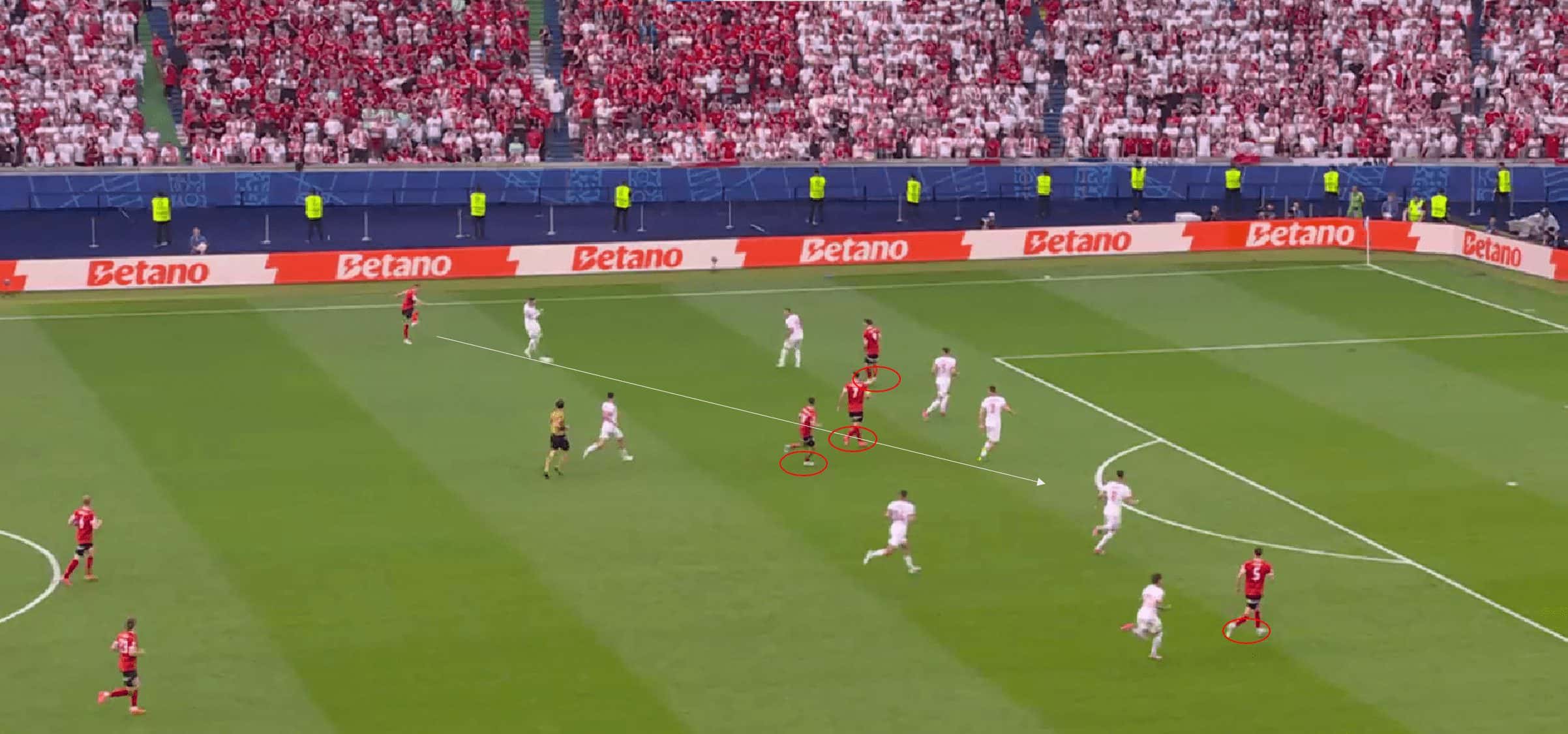
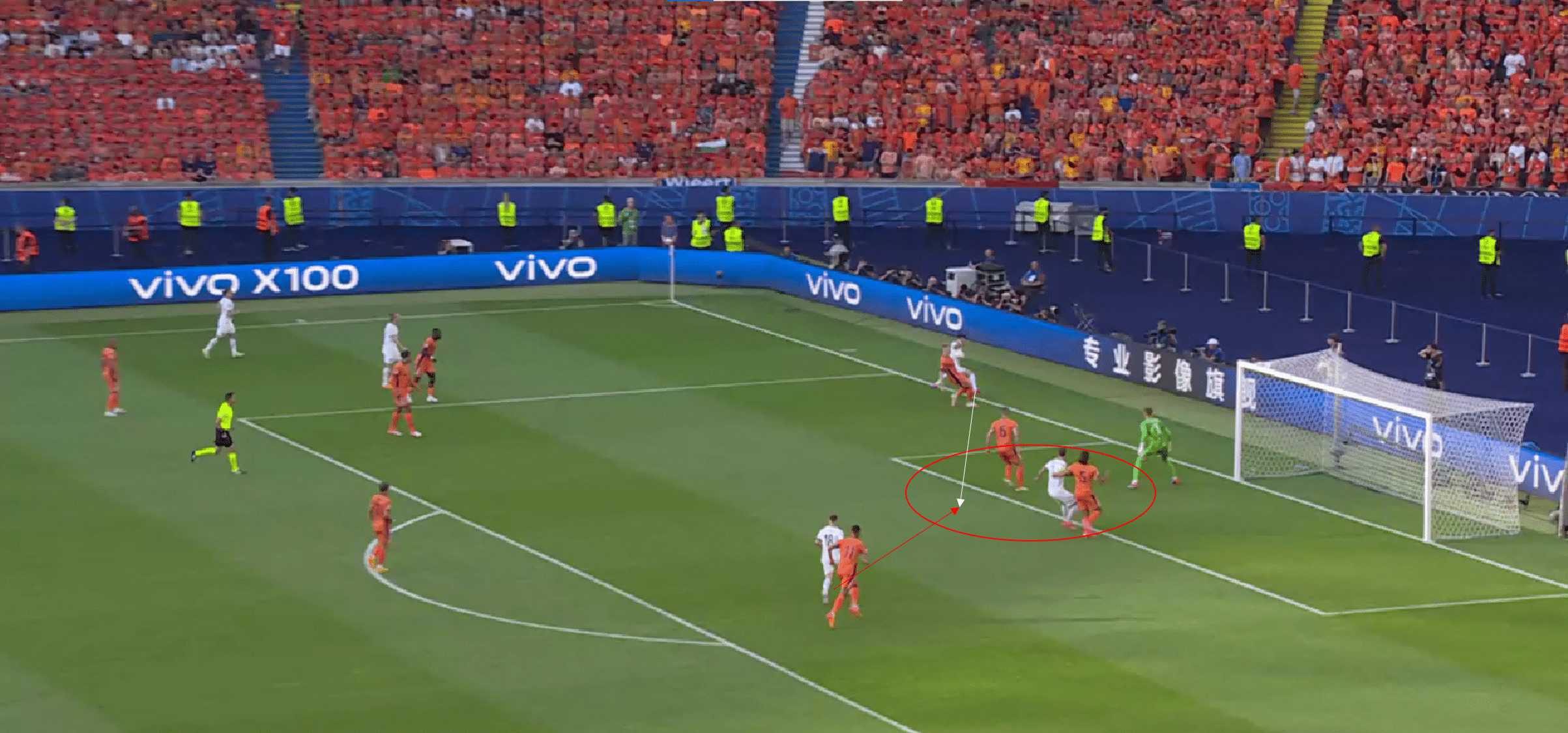
Obviously, Rangnick needs to find other ways to score goals as well.
A team should never be one-dimensional in its approach.
But you know how the saying goes: never change a running system.
Conclusion
Overall, Austria’s success at the Euros this year isn’t just coming from pure luck.
Topping a group with the Netherlands and France is a considerable achievement.
Rangnick managed to get the most out of his team during the three group games and now faces a surprisingly manageable path towards the semi-final.
Their tactics and style of play resemble Germany in many ways, and they even proved that they can put it onto the pitch against the toughest opposition in the tournament.
Their in-possession play is working very well because they can force a high number of players into the box and create a lot of counterpressing opportunities.
Austria still struggles against elite Wingers like Mbappé or Dembélé, and it is very left-side-dependent in its approach to offence, which teams will try to exploit from now on.
But looking back at the past months and games, there is no reason to believe that Austria will crumble.
The knockout stages of tournaments always bring out the best or the worst of teams, and it will be fascinating to see how Austria manages under the pressure their great performances have put on them.






Comments